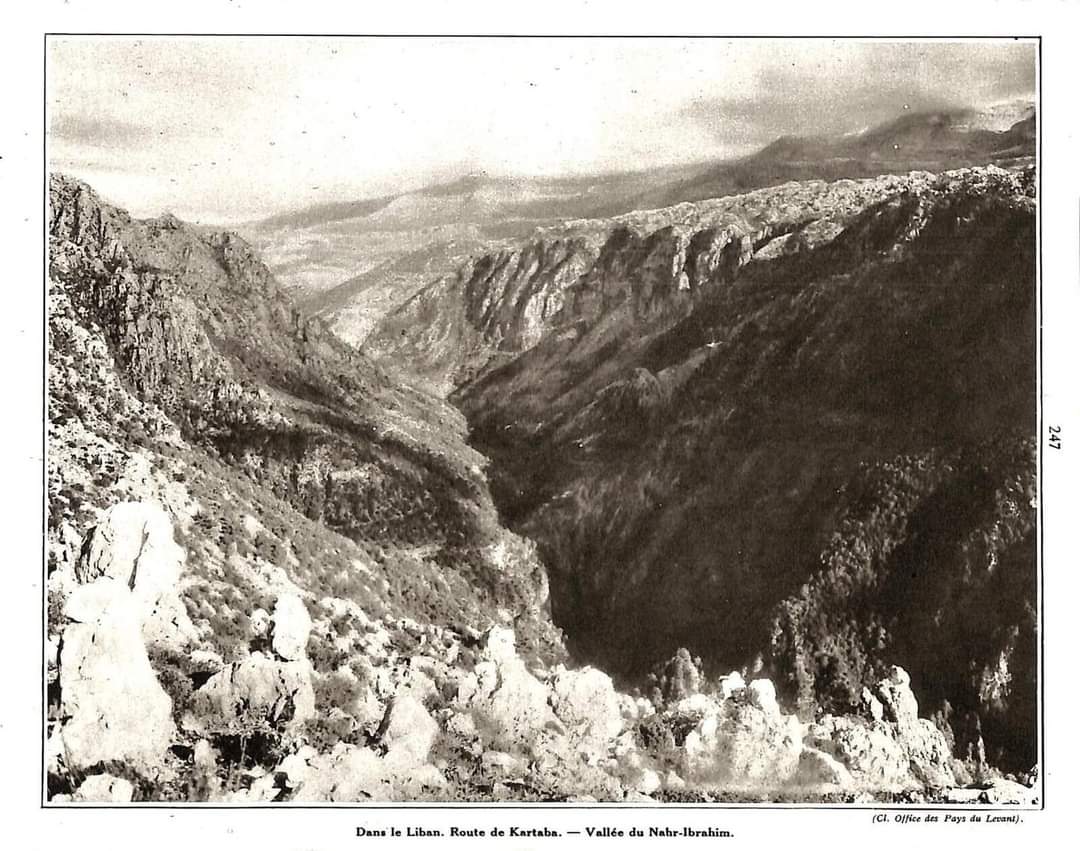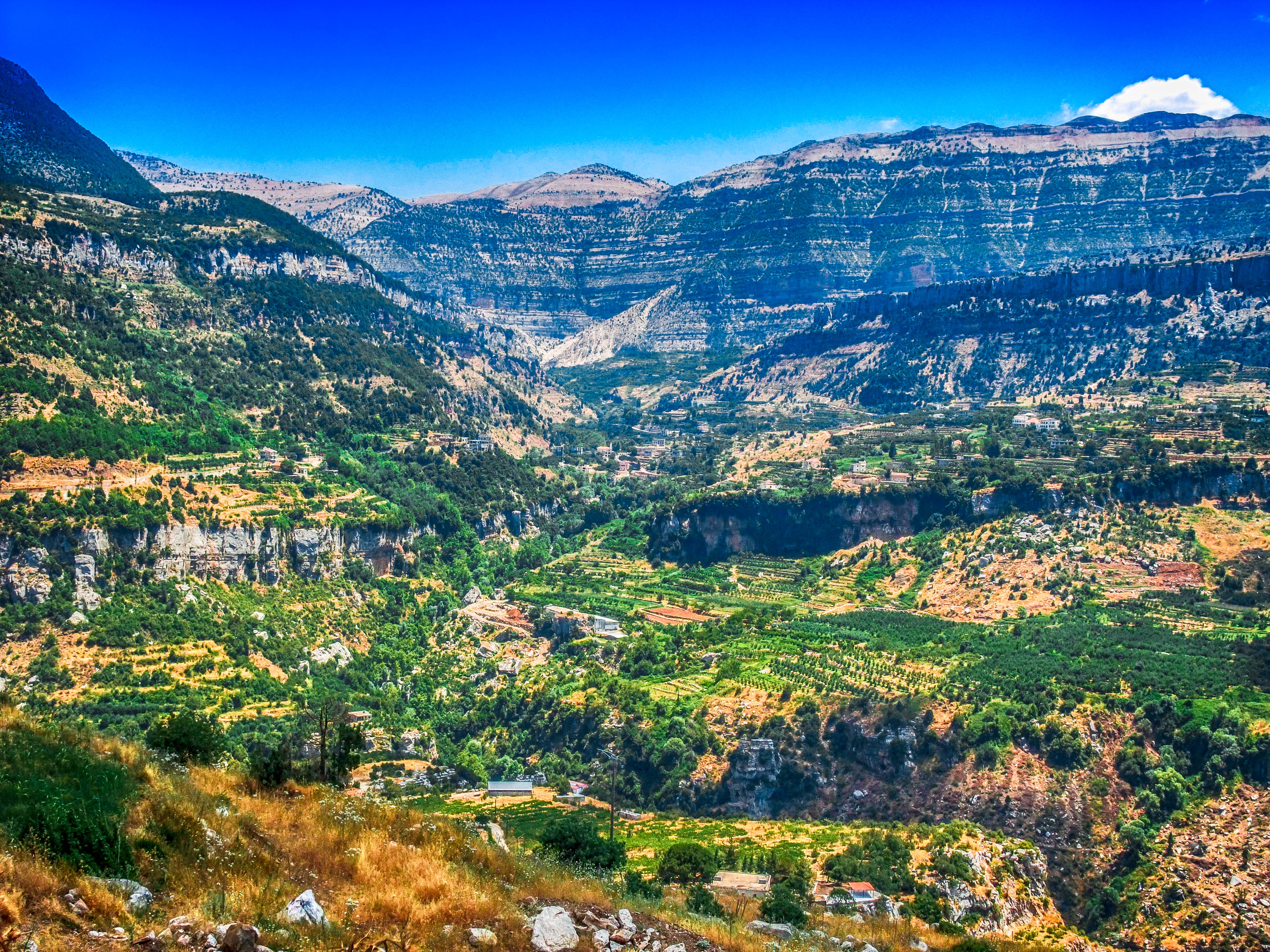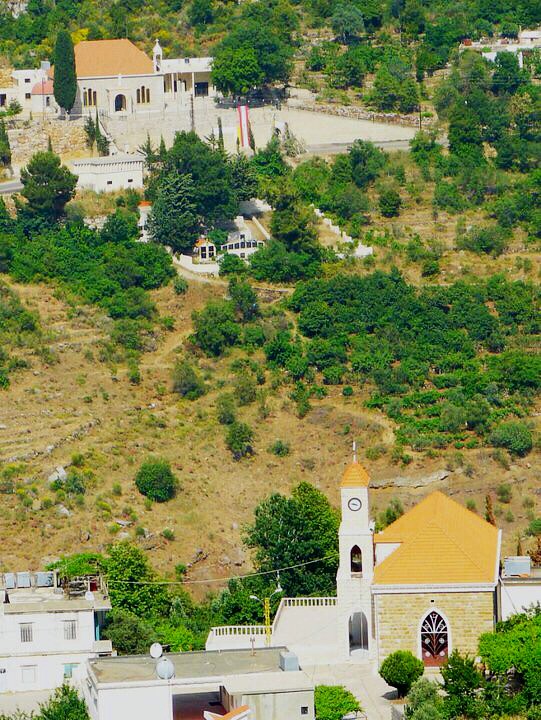|
Qartaba
Qartaba ( ar, قرطبا, also spelled ''Kartaba'' or ''Artaba'') is a mountainous town in the Byblos District of the Keserwan-Jbeil Governorate, Lebanon. It is located 57 kilometers north Beirut on the mountains above Byblos at an average altitude of 1,250 meters. Qartaba is surrounded by olive groves, apple orchards, and vineyards. Etymology In Syriac, Qartaba means either a good place (ܟܘܪ ܛܒܐ) or nice chillness (ܩܪܛܒܐ) reflecting its good, curing, and balanced weather. The town is often referred to as Byblos' Bride. History Qartaba was once considered an important village in the Byblos highland, a trade point for surrounding villages. Silk manufacturing flourished and in 1918, seven factories employed more than 500 people and much of the silk was exported to Lyon, France. Archeology A column carved into the facade of two temples, with statues of members of an elite Roman family was discovered in 1940 in Qartaba, near the Saint Sarkis and Bacchus Monastery. It i ... [...More Info...] [...Related Items...] OR: [Wikipedia] [Google] [Baidu] |
Qartaba 1931
Qartaba ( ar, قرطبا, also spelled ''Kartaba'' or ''Artaba'') is a mountainous town in the Byblos District of the Keserwan-Jbeil Governorate, Lebanon. It is located 57 kilometers north Beirut on the mountains above Byblos at an average altitude of 1,250 meters. Qartaba is surrounded by olive groves, mulberry, apple orchards, and vineyards. Etymology In Syriac language, Syriac, Qartaba means either a good place (ܟܘܪ ܛܒܐ) or nice chillness (ܩܪܛܒܐ) reflecting its good, curing, and balanced weather. The town is often referred to as Byblos' Bride. History Qartaba was once considered an important village in the Byblos highland, a trade point for surrounding villages. Silk manufacturing flourished and in 1918, seven factories employed more than 500 people and much of the silk was exported to Lyon, France. Archeology A column carved into the facade of two temples, with statues of members of an elite Roman Empire, Roman family was discovered in 1940 in Qartaba, near the ... [...More Info...] [...Related Items...] OR: [Wikipedia] [Google] [Baidu] |
Byblos District
Byblos District ( ar, قضاء جبيل; transliteration: ''Qadaa' Jbeil''), also called the Jbeil District (''Jbeil'' is Lebanese Arabic for "Byblos"; standard Arabic ''Jubail''), is a district (''qadaa'') of the Keserwan-Jbeil Governorate of Lebanon. It is located to the northeast of Lebanon's capital Beirut. The capital is Byblos. The rivers of al-Madfoun and Nahr Ibrahim form the district's natural northern and southern borders respectively, with the Mediterranean Sea bordering it from the west and Mount Lebanon from the east, separating it from the adjacent district of Baalbek in the Beqaa Valley. Demographics The district's population is predominantly Maronite Catholic, followed by a Shia Muslim minority community. The largest towns of the district are predominantly inhabited by Maronites; they are Byblos, Qartaba, Aqoura and Amsheet. Most Shia Muslims live in the valley of the Ibrahim River, particularly in the villages of Almat, Ras Osta, Hjoula, Bichtlida, Lassa, and ... [...More Info...] [...Related Items...] OR: [Wikipedia] [Google] [Baidu] |
Acar (surname)
Belgium Acar is a rare Belgian last name. The origins of Acar come from the French last name Acart. Here, the 't' is not pronounced in spoken French, and hence was dropped in writing. Notable people with the last name include: * (1937-1976), Belgian journalist, comic book writer, notably worked on short stories for TinTin and Strapontin with René Goscinny. France Acar is a rare noble French patronymic name from Bar-Sur-Aube dating back to the 15th Century, where it is found at different times in various localities, especially in Champagne and Burgundy. Acar is also a rare Medieval French byname from Picardy. The name is a variant of Achard, Achart and Acquart. Notable people with this surname include: Jean-Rémy Acar, Director General of La Fédération des particuliers employeurs de France (FEPEM) Lebanon Acar (Aramaic: ܥܟܪ; Western Syriac-Aramaic: ܥܳܟܶܪ; Hebrew: עכר) is a Lebanese Christian last name of Aramaic origin. In Lebanon, the last name Acar mea ... [...More Info...] [...Related Items...] OR: [Wikipedia] [Google] [Baidu] |
List Of Sovereign States
The following is a list providing an overview of sovereign states around the world with information on their status and recognition of their sovereignty. The 206 listed states can be divided into three categories based on membership within the United Nations System: 193 UN member states, 2 UN General Assembly non-member observer states, and 11 other states. The ''sovereignty dispute'' column indicates states having undisputed sovereignty (188 states, of which there are 187 UN member states and 1 UN General Assembly non-member observer state), states having disputed sovereignty (16 states, of which there are 6 UN member states, 1 UN General Assembly non-member observer state, and 9 de facto states), and states having a special political status (2 states, both in free association with New Zealand). Compiling a list such as this can be a complicated and controversial process, as there is no definition that is binding on all the members of the community of nations concerni ... [...More Info...] [...Related Items...] OR: [Wikipedia] [Google] [Baidu] |
Roman Empire
The Roman Empire ( la, Imperium Romanum ; grc-gre, Βασιλεία τῶν Ῥωμαίων, Basileía tôn Rhōmaíōn) was the post-Republican period of ancient Rome. As a polity, it included large territorial holdings around the Mediterranean Sea in Europe, North Africa, and Western Asia, and was ruled by emperors. From the accession of Caesar Augustus as the first Roman emperor to the military anarchy of the 3rd century, it was a Principate with Italia as the metropole of its provinces and the city of Rome as its sole capital. The Empire was later ruled by multiple emperors who shared control over the Western Roman Empire and the Eastern Roman Empire. The city of Rome remained the nominal capital of both parts until AD 476 when the imperial insignia were sent to Constantinople following the capture of the Western capital of Ravenna by the Germanic barbarians. The adoption of Christianity as the state church of the Roman Empire in AD 380 and the fall of the Western ... [...More Info...] [...Related Items...] OR: [Wikipedia] [Google] [Baidu] |
Greek Orthodox
The term Greek Orthodox Church (Greek language, Greek: Ἑλληνορθόδοξη Ἐκκλησία, ''Ellinorthódoxi Ekklisía'', ) has two meanings. The broader meaning designates "the Eastern Orthodox Church, entire body of Orthodox (Chalcedonian) Christianity, sometimes also called 'Eastern Orthodox,' 'Greek Catholic,' or generally 'the Greek Church. The narrower meaning designates "any of several Autocephaly, independent churches within the worldwide communion of Eastern Orthodoxy, [Eastern] Orthodox Christianity that retain the use of the Greek language in formal ecclesiastical settings". Etymology Historically, the term "Greek Orthodox" has been used to describe all Eastern Orthodox churches, since the term "Greek" can refer to the heritage of the Byzantine Empire. During the first eight centuries of Christian history, most major intellectual, cultural, and social developments in the Christian Church took place in the Byzantine Empire or its Byzantine commonwealth, sphe ... [...More Info...] [...Related Items...] OR: [Wikipedia] [Google] [Baidu] |
Melkite Catholics
el, Μελχιτική Ελληνική Καθολική Εκκλησία , image = Melkite Greek Catholic Church, Damascus, Syria.jpg , imagewidth = 200px , alt = , caption = , abbreviation = , type = Antiochian , main_classification = Eastern Catholic , orientation = Melkite , scripture = , theology = Catholic Theology , polity = Episcopal , governance = , structure = , leader_title = Pope , leader_name = Francis , leader_title1 = Primate , leader_name1 = Patriarch Youssef Absi , leader_title2 = , leader_name2 = Cyril VI Tanas , leader_title3 = , leader_name3 = , fellowships_type = , fellowships = , fellowships_type1 = , fellowships1 = , division_type = , division = , division_type1 = , division1 = , div ... [...More Info...] [...Related Items...] OR: [Wikipedia] [Google] [Baidu] |
Maronite Catholics
The Maronite Church is an Eastern Catholic '' sui iuris'' particular church in full communion with the pope and the worldwide Catholic Church, with self-governance under the Code of Canons of the Eastern Churches. The current head of the Maronite Church is Patriarch Bechara Boutros al-Rahi, who was elected in March 2011 following the resignation of Patriarch Nasrallah Boutros Sfeir. The current seat of the Maronite Patriarchate is in Bkerke, northeast of Beirut, Lebanon. Officially known as the Antiochene Syriac Maronite Church, it is part of Syriac Christianity by liturgy and heritage. The early development of the Maronite Church can be divided into three periods, from the 4th to the 7th centuries. A congregation movement, with Saint Maron from the Taurus Mountains as an inspirational leader and patron saint, marked the first period. The second began with the establishment of the Monastery of Saint Maroun on the Orontes, built after the Council of Chalcedon to defend th ... [...More Info...] [...Related Items...] OR: [Wikipedia] [Google] [Baidu] |
Maronites
The Maronites ( ar, الموارنة; syr, ܡܖ̈ܘܢܝܐ) are a Christian ethnoreligious group native to the Eastern Mediterranean and Levant region of the Middle East, whose members traditionally belong to the Maronite Church, with the largest concentration long residing near Mount Lebanon in modern Lebanon. The Maronite Church is an Eastern Catholic particular church in full communion with the Pope and the rest of the Catholic Church, whose membership also includes non-ethnic Maronites. The Maronites derive their name from the Syriac Christian saint Maron, some of whose followers migrated to the area of Mount Lebanon from their previous place of residence around the area of Antioch, and established the nucleus of the Antiochene Syriac Maronite Church. Christianity in Lebanon has a long and continuous history. Biblical scriptures purport that Peter and Paul evangelized the Phoenicians, whom they affiliated to the ancient patriarchate of Antioch. The spread of Christianity in ... [...More Info...] [...Related Items...] OR: [Wikipedia] [Google] [Baidu] |
National Museum Of Beirut
The National Museum of Beirut ( ar, متحف بيروت الوطنيّ, ''Matḥaf Bayrūt al-waṭanī'' or French language, French: Musée national de Beyrouth) is the principal museum of archaeology in Lebanon. The collection begun after World War I, and the museum was officially opened in 1942. The museum has collections totaling about 100,000 objects, most of which are antiquities and medieval finds from excavations undertaken by the Directorate General of Antiquities. About 1300 artifacts are exhibited, ranging in date from History of ancient Lebanon, prehistoric times to the History of Lebanon under Arab rule, medieval Mamluk period. During the 1975 Lebanese Civil War, the museum stood on the front line that separated the warring factions. The museum's Egyptian Revival architecture, Egyptian Revival building and its collection suffered extensive damage in the war, but most of the artifacts were saved by last-minute preemptive measures. Today, after a major renovation, th ... [...More Info...] [...Related Items...] OR: [Wikipedia] [Google] [Baidu] |
Germanus Priest Qartaba
Germanus or Germanos (Greek) may refer to: People *Lucius Trebius Germanus, governor of Roman Britain around 126 *Germanus (died c. 290), possibly apocryphal martyr-saint tortured at the Pula Arena *Germanus (4th century), Spanish martyr-saint (see Servandus and Cermanus) *Germanus of Auxerre (378–448), bishop of Auxerre who founded the Carolingian abbey of Saint-Germain en Auxerre named for the same saint *Germanus of Man (410–475), saint *Germain of Paris (Latin: Germanus) (496–576), bishop of Paris, Roman Catholic and Eastern Orthodox saint *Germanus of Capua (died 541), archbishop from 519 *Germanus (cousin of Justinian I) (died 550), general of the Byzantine Empire *Germanus (Caesar), son-in-law of Tiberius II Constantine *Germanus (patricius) (died 605/606), leading senator in the reign of Emperor Maurice *Germanus (magister militum under Phocas) (died 604) *Germanus of Granfelden (612–675), saint *Germanus I, Patriarch of Bulgaria (972–990) *Germanus of Wincheste ... [...More Info...] [...Related Items...] OR: [Wikipedia] [Google] [Baidu] |
Mazraat Es-Siyad
Mazraat es-Siyad (also transliterated ''Mazraet es-Siyed''; ar, مزرعة السياد ) is a mountainous village in the highlands of the Byblos District in the Keserwan-Jbeil Governorate, Lebanon. The town is away from Beirut, and stands at an elevation of above sea level. Etymology/History ''Mazraat es-Siyad'' translates as "grange of the masters" in Arabic. It is named after the Shia siyyad (masters) of the al-Husseini family, whose ancestor, Sayyed Hussein al-Husseini was the first person to reside in the area after he restored an ancient monastery. The monastery was bestowed to him by Sheikh Nawfal Ibrahim al-Khoury during the Mamluk era (13th–15th centuries). Geography Mazraat es-Siyyad is located in the Byblos District in the Mount Lebanon Governorate. It is 58 kilometers north of the capital Beirut. It spans an area of and stands at an altitude of above sea level. The municipal area of Mazraat es-Siyad includes the hamlets of Abboud, Mazraat er- Rmeileh, Sha ... [...More Info...] [...Related Items...] OR: [Wikipedia] [Google] [Baidu] |








